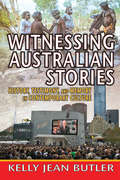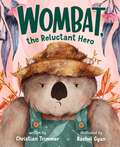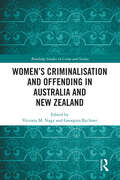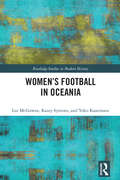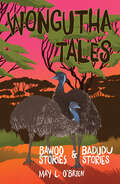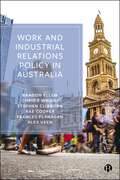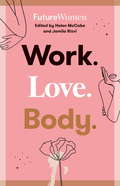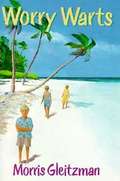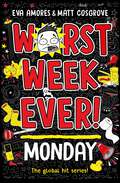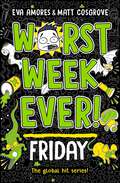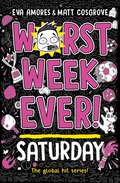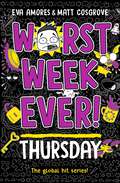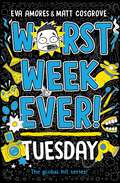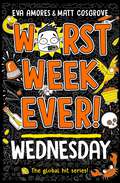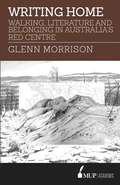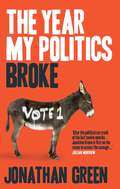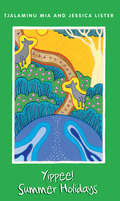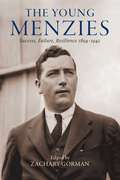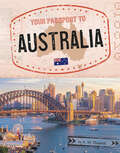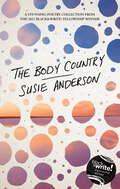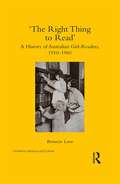- Table View
- List View
Witnessing Australian Stories: History, Testimony, and Memory in Contemporary Culture (Memory And Narrative Ser.)
by Kelly Jean ButlerThis book is about how Australians have responded to stories about suffering and injustice in Australia, presented in a range of public media, including literature, history, films, and television. Those who have responded are both ordinary and prominent Australians—politicians, writers, and scholars. All have sought to come to terms with Australia's history by responding empathetically to stories of its marginalized citizens.Drawing upon international scholarship on collective memory, public history, testimony, and witnessing, this book represents a cultural history of contemporary Australia. It examines the forms of witnessing that dominated Australian public culture at the turn of the millennium. Since the late 1980s, witnessing has developed in Australia in response to the increasingly audible voices of indigenous peoples, migrants, and more recently, asylum seekers. As these voices became public, they posed a challenge not only to scholars and politicians, but also, most importantly, to ordinary citizens.When former Prime Minister Kevin Rudd delivered his historic apology to Australia's indigenous peoples in February 2008, he performed an act of collective witnessing that affirmed the testimony and experiences of Aboriginal Australians. The phenomenon of witnessing became crucial, not only to the recognition and reparation of past injustices, but to efforts to create a more cosmopolitan Australia in the present. This is a vital addition to Transaction's critically acclaimed Memory and Narrative series.
Wombat Said Come In
by Carmen Agra DeedyA kindhearted wombat offers refuge to a parade of animal friends during an Australian bushfire in a delightful new picture book from New York Times best-selling creators Carmen Agra Deedy and Brian Lies. Australian bushfires roar above Wombat&’s home. He is fortunate that his burrow is deep below ground and he is safe. He snuggles under his crazy quilt and drinks his tea. Then, one by one, five uniquely Australian animals – Wallaby, Kookaburra, Platypus, Koala, and Sugar Glider – seek refuge from the fires, and Wombat welcomes them all.When you have the heart of a wombat, there&’s always room for one more! Fellowship, empathy, and adorable Australian animals star in this delightfully heartwarming and funny story about help in the time of trouble from author Carmen Agra Deedy (14 Cows for America, The Library Dragon, The Rooster Who Would Not Stay Quiet) and Caldecott Honoree Brian Lies (The Rough Patch, Bats at the Beach). The book will delight children with Deedy&’s engaging story and Lies masterfully rendered animals. It is an ideal read-aloud for adults seeking a story with humor and heart. Generosity and kindness provide powerful SEL themes. Older readers will get a glimpse of the unique environmental challenges presented by the country&’s annual bushfire season.
Wombat, the Reluctant Hero
by Christian TrimmerA heartwarming and playful adventure that will inspire young readers to be a good neighbor and friend, based on the brave actions of the Australian wombat.Wombat liked her things just so. Everything had its place, and nothing was out of order.She couldn’t say the same about her neighbors. But that was their business, and Wombat didn’t concern herself with others’ business. When a very hot, dry summer causes dangerous fires in their neighborhood, a group of animals are desperate to find water and shelter. It will take the quiet heroism of a neighbor to provide resources and a cozy, cool, and safe burrow—a reluctant wombat who demonstrates the inspiring power of community. Wombat, the Reluctant Hero is inspired by the heroic and very real actions of the wombat, an animal that has helped other creatures survive droughts and wildfires in its native Australia. Author Christian Trimmer and illustrator Rachel Gyan celebrate this amazing mammal, who definitely has a thing or two to teach us about being a good neighbor.
Women’s Criminalisation and Offending in Australia and New Zealand (Routledge Studies in Crime and Society)
by Victoria M. Nagy Georgina RychnerWomen’s Criminalisation and Offending in Australia and New Zealand offers new research and analysis of women’s offending and criminalisation in Australia and New Zealand from British settlement through to the late twentieth/early twenty-first centuries. Drawing attention to women as offenders as understood in a multitude of ways, this collection highlights how women have been involved with crime and criminal behaviour, their treatment inside and outside of courts and prisons, and how women’s deviation from societal norms have attracted negative attention throughout the decades. For Aboriginal and Māori women especially, the responses were harsher than what they could be for non-indigenous women. The chapters cover a broad range of transgressions that women have been actively involved with, including theft, drug and alcohol abuse and offences, organised crime, and homicide, as well as how women’s behaviour and their bodies have been criminalised and responded to by authorities. What this collection demonstrates is that women have often chosen to be involved with crime and criminality, while on other occasions their behaviour, innocent as it was, was not considered acceptable by contemporaries, resulting in confusion and misapprehension of women who refused to fit a mould. Women’s Criminalisation and Offending in Australia and New Zealand brings together historical and criminological methods, theories, and scholars to shed light on how Australia and New Zealand’s colonial, later state, and national governments have sought to understand, control, and punish women. This collection will be of interest and value to scholars, students, and everyone with an interest in criminology, history, law, sociology, Indigenous studies, and Australian and New Zealand studies.
Women’s Football in Oceania (Routledge Studies in Modern History)
by Lee McGowan Yoko Kanemasu Kasey SymonsThis book presents the most comprehensive mapping and analysis of women’s football in Oceania and is the first to examine the game’s historical development alongside social, political and cultural issues, weaving origin stories with players’ day-to-day challenges. Alongside presentation of the contemporary state of play and its overarching narrative of women’s game in the region, the book highlights key issues, discusses established and emergent themes, examines relevant contexts, investigates the status of the game at local and national levels and lays foundations for further research. Its primary objective is to detail and illustrate the historical, social, and organisational development of the women’s game, including international tournaments, national competitions, and teams in an effort to amplify the efforts of the individuals that made or make a significant contribution to the game. It draws on extensive formal and informal discussion, realises insight, proposes the means and related fields of further investigation and generates new knowledge alongside the uncovering of old. Women’s Football in Oceania covers key events, actors and moments and fills a gap in research for scholars of sports history and women’s history.
Wongutha Tales
by May O'BrienFirst published as individual titles in 1992, May O' Brien' s stories were ground-breaking publications, presenting traditional Indigenous stories in a bilingual text and giving a unique insight into learning English as a second language from a First Nations perspective. Classic tales such as How Crows Became Black and Why the Emu Can' t Fly are still as fresh and appealing as ever for a new generation of junior readers. Plus May' s simple pronunciation guide for Wongutha words are perfect learning activities for the classroom.
Work and Industrial Relations Policy in Australia
by Chris F. Wright Frances Flanagan Bradon Ellem Stephen Clibborn Rae Cooper Alex VeenThis book provides a comprehensive analysis of the institutions and processes shaping work, labour markets and industrial relations policies in Australia. It explores traditional industrial relations issues and examines social change and policy failures in areas such as gender, work and family dynamics, skills and immigration and wage theft. Additionally, it considers how pandemics, climate change, technological advances and new business structures impact policy change. Addressing these universal challenges, the book offers fresh conceptual approaches and rethinks policy problems and solutions. Essential reading for scholars, students, and practitioners, this book reshapes our understanding of work and industrial relations policy.
Work. Love. Body.: Future Women
by Helen McCabe Jamila RizviIn 2020, the lives of Australian women changed irrevocably. With insight, intelligence and empathy, Jane Gilmore, Santilla Chingaipe and Emily J. Brooks explore this through the lenses of work, love and body, and ask: Will the Australia of tomorrow be more equal than the one we were born into? Or will women and girls remain left behind?While our country was shrouded in smoke in the early months of 2020, Australian women went about their daily business. They worked, studied, cleaned, did school runs, made meals. And they postponed looking after themselves because life got in the way.Then, in March, Australians were told to lock down. For all the talk of equality, it was primarily women who held the health of our communities in their hands as they took on the essential jobs to care, to nurse and to teach, despite an invisible danger. One year later, women across the country would march on behalf of those who were not safe in workplaces and their own homes.Never before has change been thrust so abruptly on modern Australian women - 2020 impacted our working lives, relationships and our health and wellbeing. And as a growing number of women agitate for change, it is time to demand what women want. So where do we go from here?One thing is very clear: the future is now, and it is female.
Worry Warts
by Morris GleitzmanWorried because his parents' constant fighting has been aggravated by their financial troubles, twelve-year-old Keith decides to solve the problem by running away to pick up a fortune in the Australian opal fields.
Worst Week Ever! Monday (Worst Week Ever! Ser.)
by Matt Cosgrove Eva AmoresHave YOU ever had a bad week? Start Monday with a bang in the hilarious new series taking the world by storm. His mum just married a vampire, his dad is driving a giant toilet on wheels, and his cat&’s been abducted by aliens (probably). Justin Chase is having the WORST WEEK EVER! And that&’s all before he&’s even started his first day at a brand-new school. At least he has the perfect chance to show off his prowess in the swimming pool, right? Maybe not... As right now, he's dangling off the edge of a 10-metre-high diving tower in front of his entire class wearing nothing but rapidly disappearing crocheted trunks! And it's only... MONDAY! The first book in the hilarious new seven-part highly-illustrated series for fans of Tom Gates, Diary of a Wimpy Kid and the Treehouse series.
Worst Week Ever! Friday (Worst Week Ever! #5)
by Matt Cosgrove Eva AmoresHave YOU ever had a bad week? The hilarious new series taking the world by storm. He&’s fallen down a giant hole, he&’s plummeted down to the very depths, he&’s TRAPPED underground in the darkest, dingiest, most abysmal abyss. Justin Chase is having the WORST WEEK EVER! There&’s no bright side this time as Justin must blindly face what lies below, be it friend, foe or fatberg... Against all odds, he survived the trials and torments of Monday, Tuesday, Wednesday AND Thursday, but now it's ... FRIDAY!The fifth book in the hilarious new seven-part highly-illustrated series for fans of Tom Gates, Diary of a Wimpy Kid and the Treehouse series.
Worst Week Ever! Saturday (Worst Week Ever! #6)
by Matt Cosgrove Eva AmoresHave YOU ever had a bad week? The hilarious new series taking the world by storm. He&’s been naked in front of the whole school, survived a marooning, a kidnapping AND a giant sinkhole, and every one of these cringe inducing moments has gone mega viral! Justin Chase is having the WORST WEEK EVER! Time for nice relaxing weekend, right? WRONG! As Justin must face his spookiest challenge yet… zombies! No, really! And these aren&’t just any zombies… he lives next door to the cemetery for ELITE ATHLETES! Monday was manic, Tuesday was traumatizing, Wednesday was weird, Thursday was terrifying and Friday was frantic. But now… it&’s SATURDAY.The sixth book in the hilarious new seven-part highly-illustrated series for fans of the globally bestselling Treehouse series.
Worst Week Ever! Thursday (Worst Week Ever! #4)
by Matt Cosgrove Eva AmoresHave YOU ever had a bad week? The hilarious new series taking the world by storm. He&’s dressed up like a clown on national TV, his worst enemy is stealing the limelight, and there's definitely something weird happening with everyone's cats! Justin Chase is having the WORST WEEK EVER! At least he's found a new BFF in international pop sensation, teen heartthrob and Justin&’s name twin, Justin Chase, right? Maybe not... As a case of mistaken identity leads to a disastrous kidnapping and Justin forced to race against the clock (and the ferocious dog) to escape! Monday was mortifying, Tuesday was tumultuous, Wednesday was wild, but now it's... THURSDAY! The fourth book in the hilarious new seven-part highly-illustrated series for fans of Tom Gates, Diary of a Wimpy Kid and the Treehouse series.
Worst Week Ever! Tuesday (Worst Week Ever! Ser.)
by Matt Cosgrove Eva AmoresHave YOU ever had a bad week? The hilarious new series taking the world by storm. His cat has been abducted by aliens, his dad is dating his new head teacher, and he&’s unexpectedly gone viral online in the most embarrassing way. Justin Chase is having the WORST WEEK EVER! At least his new-found inter-fame (or inter-shame) won't stand in the way of getting the perfect school photo, right? Maybe not... As the school&’s Super Science Spectacular is destined to blow up into a hair-raising, teeth-shattering disaster of epic proportions! He barely made it through Monday, but now it&’s... Tuesday! The second book in the hilarious new seven-part highly-illustrated series for fans of Tom Gates, Diary of a Wimpy Kid and the Treehouse series.
Worst Week Ever! Wednesday (Worst Week Ever! #3)
by Matt Cosgrove Eva AmoresHave YOU ever had a bad week? The hilarious new series taking the world by storm. His cat is still missing, he&’s an unintentional internet sensation, and now he&’s trapped in a serious S.O.S situation with his unbelievably annoying archenemy! Justin Chase is having the WORST WEEK EVER! At least there&’s the chance of this totally abandoned island being home to hordes of secret treasure, right? Maybe not... As the island seems only to house terrifying sharks, petrifying pirates and anything capable of chilling Justin right down to his bones! Monday was messy, Tuesday was an embarrassment, but now it&’s... WEDNESDAY! The third book in the hilarious new seven-part highly-illustrated series for fans of Tom Gates, Diary of a Wimpy Kid and the Treehouse series.
Writing Home: Walking, Literature and Belonging in Australia's Red Centre
by Glenn MorrisonWriting Home explores the literary representation of Australian places by those who have walked them. In particular, it examines how Aboriginal and settler narratives of walking have shaped portrayals of Australia's Red Centre and consequently ideas of nation and belonging.Central Australia has long been characterised as a frontier, the supposed divide between black and white, ancient and modern. But persistently representing it in this way is preventing Australians from re-imagining this internationally significant region as home. Writing Home argues that the frontier no longer adequately describes Central Australia, and that the Aboriginal songlines make a significant but under-acknowledged contribution to Australian discourses of hybridity, belonging and home. Drawing on anthropology, cultural theory, journalism, politics and philosophy, the book traces shifting perceptions of Australian place and space since precolonial times, through six recounted walking journeys of the Red Centre.
Year My Politics Broke
by Jonathan GreenIs there more to politics than politics? What about sincere belief? Or conviction? Both are missing in action, trumped by political expedience. We've just sat through an election campaign in which the major parties fought a pitched battle over precious little, two bitterly adversarial political organisations scrambling desperately for the middle ground, aiming for the broadest common denominator. But the problem is bigger than just this election. We are living through a moment in which the pursuit of power seems the sole objective of political activity. True for Julia Gillard, Kevin Rudd and Tony Abbott. Shouldn't someone hold them to account? Our political media perhaps? Why does it just report politics as show business? The sum of it leaves the rest of us short-changed. In The Year My Politics Broke, Jonathan Green looks at where politics, truth and disconnection collide.
Yippee! Summer Holidays
by Tjalaminu Mia Jessica ListerDebbie and Billy just love the summer holidays, especially when their grandfather comes to stay. They have lots of fun racing tires, telling stories, and discovering the secret places Dada Kean knows about. A beautifully illustrated Aboriginal book, this entertaining modern-day fable underscores the importance of family and caring for the environment.
Young Menzies: Success, Failure, Resilience 1894–1942
by Zachary GormanSir Robert Menzies is a towering figure in Australian history. As the nation's longest-serving prime minister, he transformed and ultimately dominated the political landscape, implementing policies that laid the foundations of modern Australia. The story of Menzies and his governments is essential to the Australian narrative: the centrality of political liberalism, the defence of democracy through trying times, and the expanding horizons of our identity, prosperity and appreciation. The Young Menzies: Success, Failure, Resilience 1894-1942 explores the formative period of Menzies's life, when his personal outlook and system of beliefs that would help shape modern Australia were themselves still being formed. Contributors look at Menzies's ideas prior to their political practice and examine their context and origins. This period is also the time in which Menzies first attained power, though in difficult circumstances, when the focus of the nation was on survival. It was in losing office that Menzies was given the impetus to develop his vision for post-war Australia. This is the first of a four-volume history of Menzies and his world, based on conferences convened by the Robert Menzies Institute at the University of Melbourne. Contributors include Frank Bongiorno, Troy Bramston, Judith Brett, Nick Cater, Justice James Edelman, David Furse-Roberts, Anne Henderson, David Kemp, Angela Kittikhoun, Greg Melleuish and Scott Prasser, with a foreword by Geoffrey Blainey.
Your Passport to Australia (World Passport)
by A.M. ReynoldsWhat is it like to live in or visit Australia? What makes Australia’s culture unique? Explore the geography, traditions, and daily lives of Australian people.
the body country
by Susie Anderson'I keep looking at the stars to see the universe, but the joke is I am the universe.' the body country is an evocative exploration of a world that too often marginalises and the power of a land that can offer connection. A meditation of wandering and wondering on Country, inviting the reader to understand the complexities and changing forms of self and love.A Wergaia and Wemba Wemba woman, Susie Anderson captures profound meaning in moments often lost in the busyness of a day, encouraging us all to stop and allow ourselves the space to notice. To notice the shape of a mouth as it says goodbye; the colour of the sky as you fall in love; the way a steering wheel is turned carelessly after many wines; the crunch of dry ground after drought; the smell of fire on the wind; the movement of ants before rain; the power a word, a dress, a piece of art can give to run towards something new. These are poems that take us across rural and urban settings; from the personal to the universal, from looking inward to mapping the land and always bringing us back to the Country that connects us all.'Anderson pays attention to the moments that slip through the cracks and hands them straight to you in a way that can momentarily stun' Harper's Bazaar'The Body Country is an evocative exploration of a world that too often marginalises and the power of a land that can offer connection. Susie captures profound meaning in moments often lost in the busyness of a day, encouraging us all to stop and allow ourselves the space to notice' Wimmera Mail Times
‘The Right Thing to Read’: A History of Australian Girl-Readers, 1910-1960
by Bronwyn Lowe‘The Right Thing to Read’: A History of Australian Girl-Readers, 1910-1960 explores the reading habits, identity, and construction of femininity of Australian girls aged between ten and fourteen from 1910 to 1960. It investigates changing notions of Australian girlhood across the period, and explores the ways that parents, teachers, educators, journalists and politicians attempted to mitigate concerns about girls’ development through the promotion of ‘healthy’ literature. The book also addresses the influence of British publishers to Australian girl-readers and the growing importance of Australian publishers throughout the period. It considers the rise of Australian literary nationalism in the global context, and the increasing prominence of Australian literature in the period after the Second World War. It also shows how access to reading material improved for girls over the first half of the last century.
